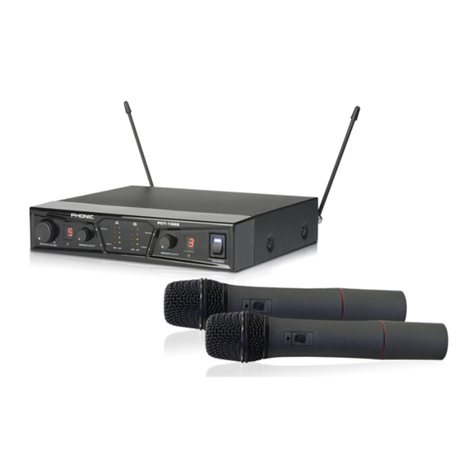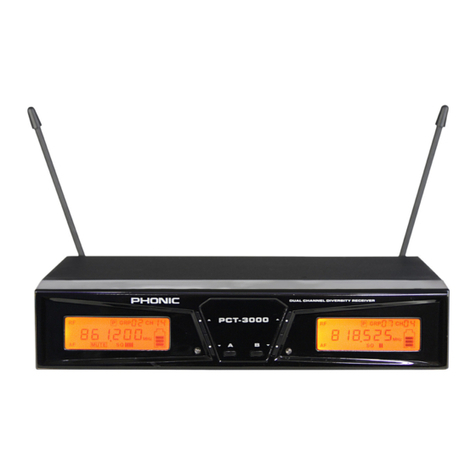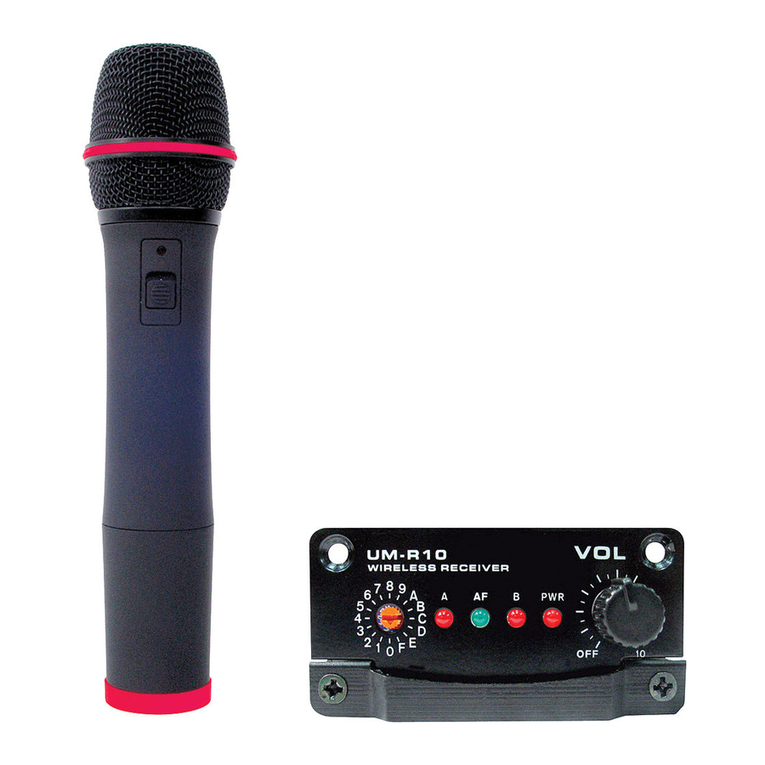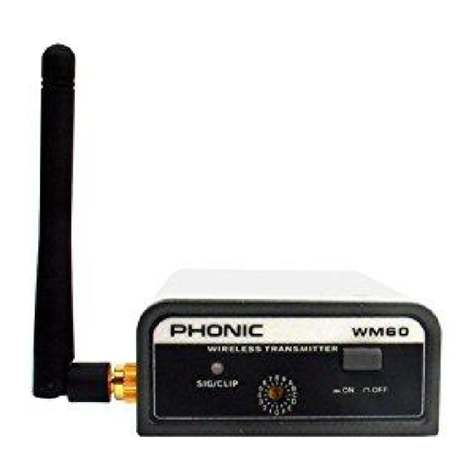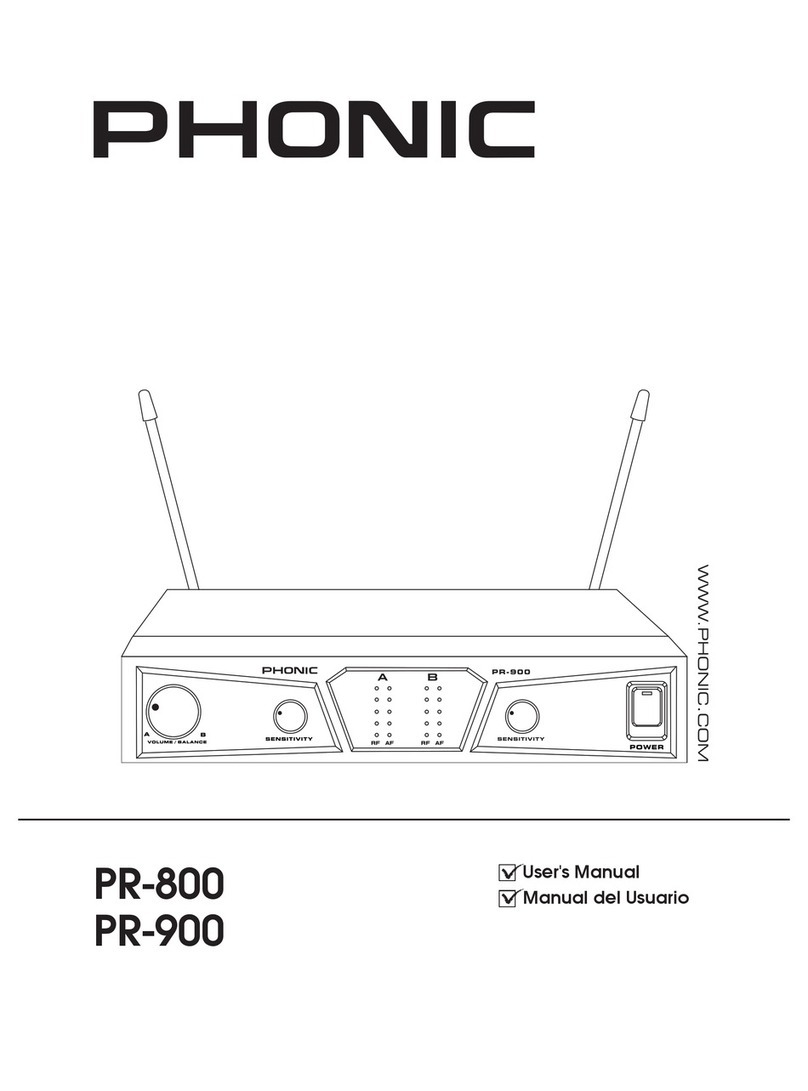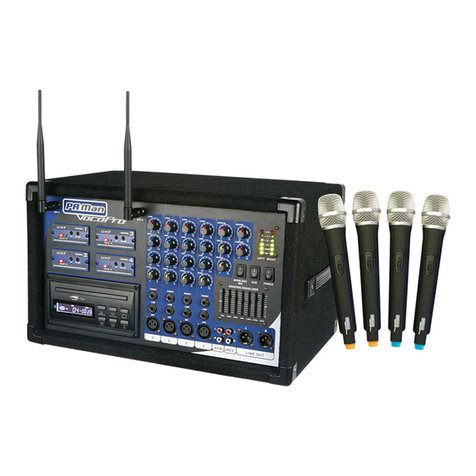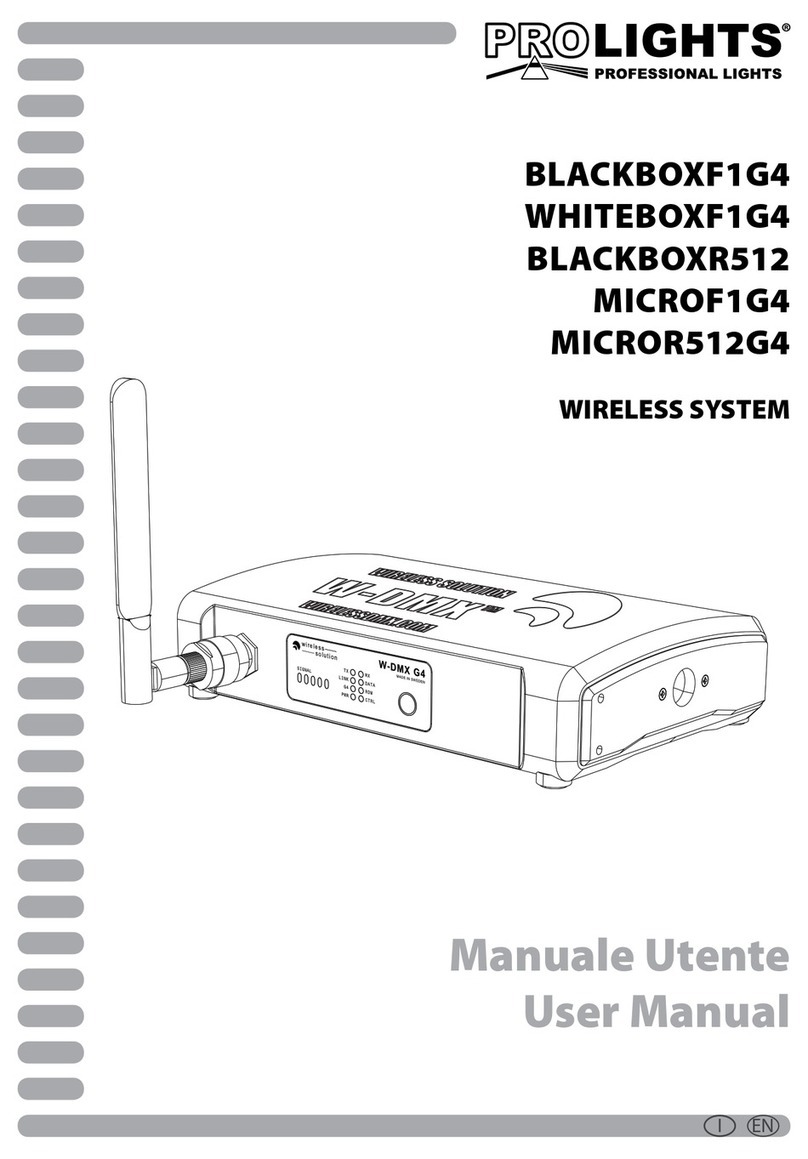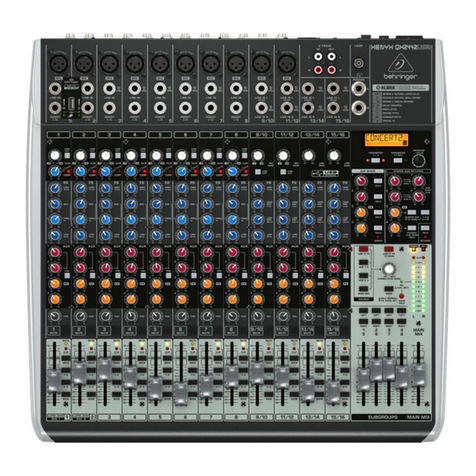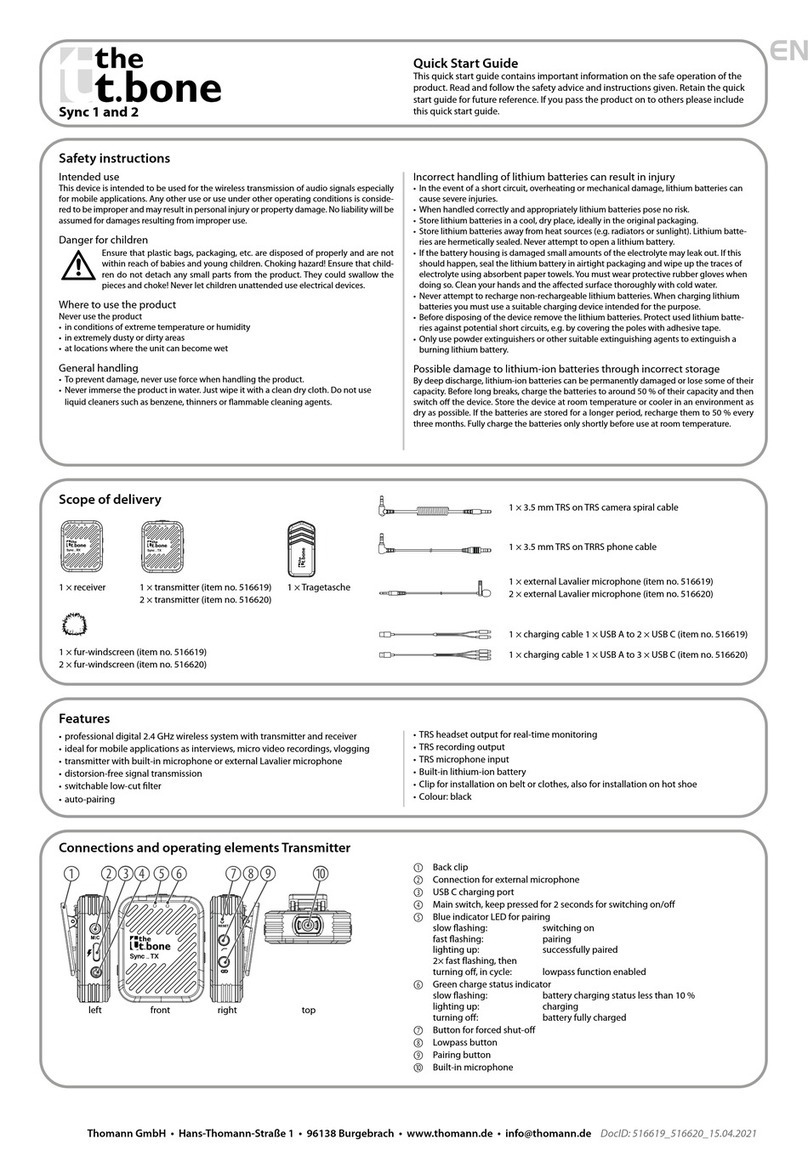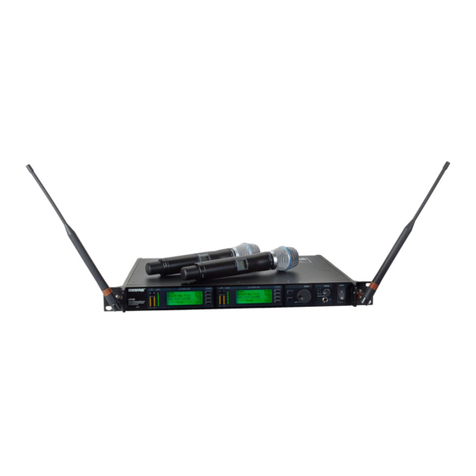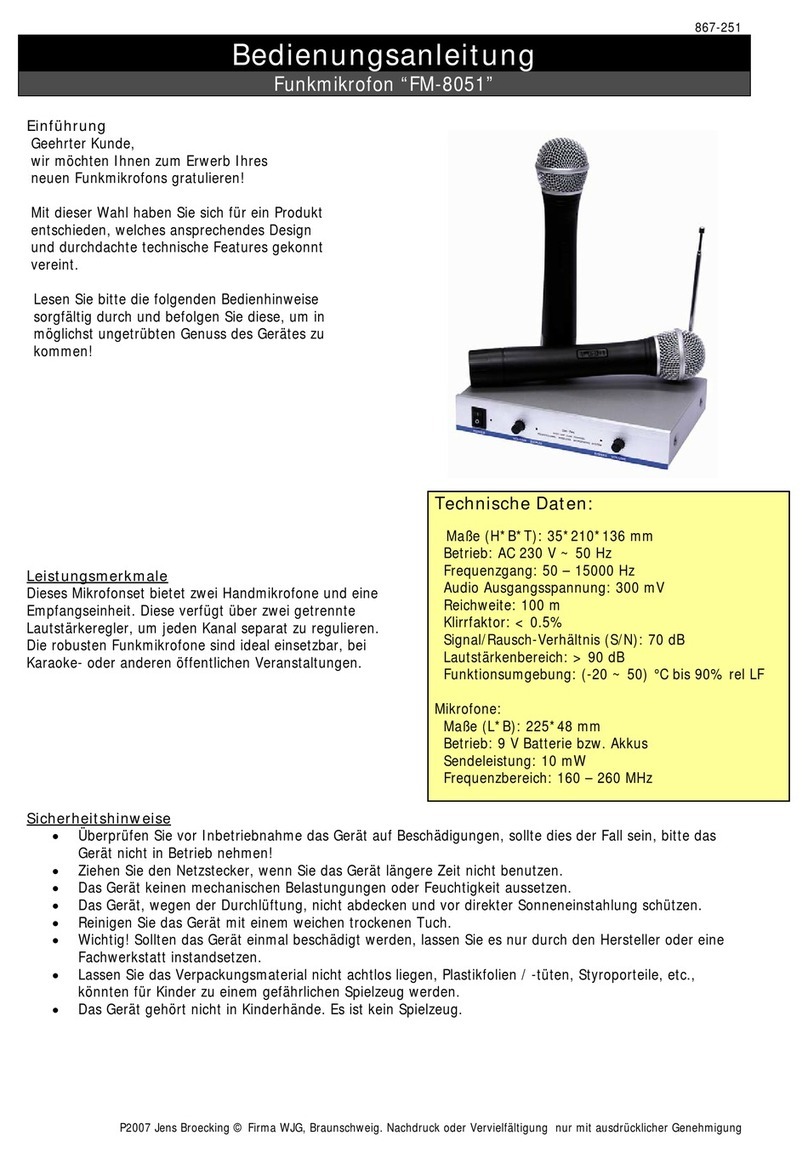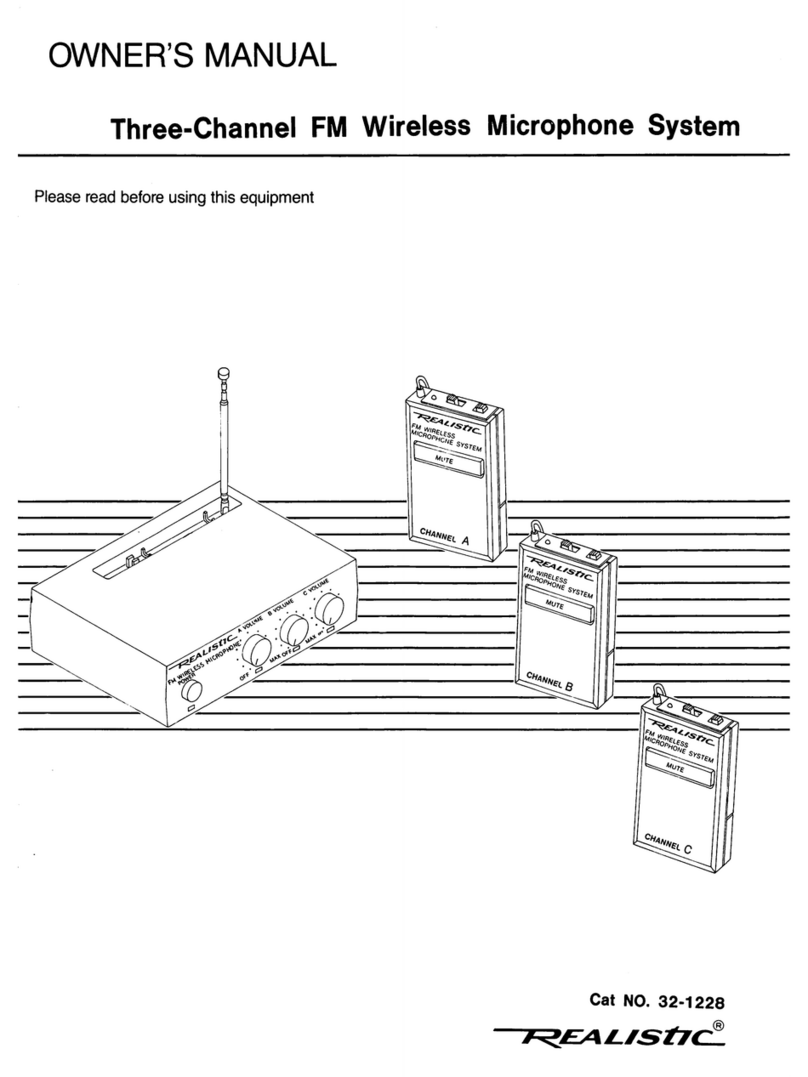Phonic WM-SYS3 User manual

1
WM-SYS3 / WM-SYS3D / WM-SYS4 / WM-SYS4D
WM-SYS3/WM-SYS3D/WM-SYS4/WM-SYS4D
Wireless Kit For Active Speakers
ENGLISH
User’s Manual
OFFON
SIG/CLIP
WIRELESS TRANSMITTER
WM60

2WM-SYS3 / WM-SYS3D / WM-SYS4 / WM-SYS4D
1. Read these instructions before operating this
apparatus.
2. Keep these instructions for future reference.
3. Heed all warnings to ensure safe operation.
4. Follow all instructions provided in this document.
5. Do not use this apparatus near water or in locations
where condensation may occur.
6. Clean only with dry cloth. Do not use aerosol or liquid
cleaners. Unplug this apparatus before cleaning.
7. Do not block any of the ventilation openings. Install
in accordance with the manufacturer
’
s instructions.
8. Do not install near any heat sources such as radiators,
heat registers, stoves, or other apparatus (including
amplifiers) that produce heat.
9. Do not defeat the safety purpose of the polarized or
grounding-type plug. A polarized plug has two blades
with one wider than the other. A grounding type plug
has two blades and a third grounding prong. The wide
blade or the third prong is provided for your safety. If
the provided plug does not fit into your outlet, consult
an electrician for replacement of the obsolete outlet.
10. Protect the power cord from being walked on or
pinched particularly at plug, convenience receptacles,
and the point where they exit from the apparatus.
11. Only use attachments/accessories specified by the
manufacturer.
12. Use only with a cart, stand, tripod, bracket, or
table specified by the manufacturer, or sold with
the apparatus. When a cart is used, use caution
when moving the cart/apparatus
combination to avoid injury from tip-
over.
13. Unplug this apparatus during lighting
storms or when unused for long
periods of time.
14. Refer all servicing to qualified service personnel.
Servicing is required when the apparatus has been
damaged in any way, such as power-supply cord or
plug is damaged, liquid has been spilled or objects
have fallen into the apparatus, the apparatus has
been exposed to rain or moisture, does not operate
normally, or has been dropped.
IMPORTANT SAFETY INSTRUCTIONS
CAUTION: TO REDUCE THE RISK OF ELECTRIC SHOCK,
DO NOT REMOVE COVER (OR BACK)
NO USER SERVICEABLE PARTS INSIDE
REFER SERVICING TO QUALIFIED PERSONNEL
The lightning flash with arrowhead symbol, within an
equilateral triangle, is intended to alert the user to the
presence of uninsulated
“
dangerous voltage
”
within the
product
’
s enclosure that may be of sufficient
magnitude to constitute a risk of electric shock to persons.
The exclamation point within an equilateral triangle is in-
tended to alert the user to the presence of important operat-
ing and maintenance (servicing) instructions in the literature
accompanying the appliance.
WARNING: To reduce the risk of fire or electric shock, do
not expose this apparatus to rain or moisture.
CAUTION: Use of controls or adjustments or performance
of procedures other than those specified may result in
hazardous radiation exposure.
The apparatus shall not be exposed to dripping or splashing and that no objects filled with liquids, such as vases,
shall be placed on the apparatus. The MAINS plug is used as the disconnect device, the disconnect device shall
remain readily operable.
Warning: the user shall not place this apparatus in the confined area during the operation so that the mains switch
can be easily accessible.
CAUTION
RISK OF ELECTRIC SHOCK
DO NOT OPEN

3
WM-SYS3 / WM-SYS3D / WM-SYS4 / WM-SYS4D
CONTENTS
Phonic reserves the right to improve or alter any information suppied within this document without prior notice.
V1.1 AUG 16, 2006
INTRODUCTION....................................................................................................... 4
SYSTEM COMPONENTS ......................................................................................... 4
FEATURES................................................................................................................ 4
QUICK SETUP .......................................................................................................... 5
Single Channel Setup..........................................................................................5
Dual Channel Setup ............................................................................................6
TROUBLESHOOTING ...............................................................................................7
WM60 TRANSMITTER ..............................................................................................8
WM70 TRANSMITTER ..............................................................................................9
WM400 RECEIVERS ...............................................................................................10
THE WM400D’S DIGITAL FEATURES ....................................................................12
CONNECTING THE WM400(D) TO A SPEAKER....................................................13
SPECIFICATIONS....................................................................................................14
EQ PRESETS ..........................................................................................................15
WM-SYS3/WM-SYS3D/WM-SYS4/WM-SYS4D
Wireless Kit For Active Speakers

4WM-SYS3 / WM-SYS3D / WM-SYS4 / WM-SYS4D
INTRODUCTION
Congratulations on your purchase of the
WM series of wireless kit for use with ac-
tive speakers. With either the stereo or
mono WM kits, you are now fast on your
way to becoming completely wireless in
your audio set up. The WM modules are
not only fantastic in style and convenience,
however; they are incredibly easy to use,
as this manual will no doubt prove.
Please have a thorough read of this
user’s manual before operating the WM
modules. Inside this guide you will nd
information on the ease of your wireless
set up, as well as some great trouble-
shooting tips and a complete run-down
on your modules’ features. After reading,
place the manual in an easy to remember
place so that you can come back to it in
future if ever necessary.
SYSTEM COMPONENTS
WM-SYS3(D) includes :
1x WM60 single channel transmitter
1x WM400(D)-L receiver
2x power supplies for WM60 and WM400(D)-L
M6, M8, M10 screws
Velcro strip
WM-SYS4(D) includes :
1x WM70 dual channel transmitter
1x WM400(D)-L left channel receiver
1x WM400(D)-R right channel receiver
3x power supplies for WM70, WM400(D)-L
and WM400(D)-R
M6, M8, M10 screws
Velcro strip
FEATURES
●
Wireless system for saving the audio
cables between your mixer and active
speakers
●
Stand-alone UHF wireless receiver,
working with any active speakers
●
12VDC external power supply (coun-
try dependent)
●
16 user-selectable frequencies
●
RF carrier frequency range :
614.175~804.800 MHz (FCC)
614.175-864.800 MHz (CE)
●
Operating range: 210 ft. (70m, envi-
ronment dependent)
●
Indicators for power on, AF and RF
●
Antenna: external, threaded connector
●
Audio output connectors: XLR out
●
Internal squelch and mute circuit
mode can resist extraneous noise
●
M6, M8, M10 screws and Velcro strip
included for attaching receiver unit to
any active speakers
“D” Systems plus:
●
300 ms digital delay processor for
compensation of different distance
speakers
●
0.1 millisecond to 300.0 millisecond
delay range, delay adjustment may be
made with 0.1 millisecond precision
●
30 preset EQ curves and variable
high cut and low cut lters
●
4-digit display to indicate frequency
channel and delay, plus AF, RF and
delay bypass indicators

5
WM-SYS3 / WM-SYS3D / WM-SYS4 / WM-SYS4D
QUICK SETUP
Single Channel Setup
With any one active speaker, users are
able to wirelessly send a monaural sig-
nal through the WM60 transmitter and
WM400(D) receiver.
1. Plug the mixer’s main output (with a
line-level signal) to either the XLR or
1/4” input of the WM60 transmitter.
2. Connect the provided DC power sup-
ply to the WM60’s and WM400(D)’s
power input and an appropriate AC
power source.
3. Adjust the channel on both the
WM60 and WM400(D) so they are
identical. If you wish to send and re-
ceive a signal successfully, this is of
utmost importance!
4. Adjust the WM60’s and WM400(D)’s
antennas into a vertical position.
5. Connect the WM400(D)’s XLR output
to the input of your active speaker.
6. Turn the WM60 on rst, then the
WM400(D).
7. Provided you have a signal going out
of your mixer, and your Speaker is
turned on, the wireless transmission
should be working.
OFFON
SIG/CLIP
WIRELESS TRANSMITTER
WM60
WM60
WM400

6WM-SYS3 / WM-SYS3D / WM-SYS4 / WM-SYS4D
Dual Channel Setup
With any active speakers, users are able
to wirelessly send stereo signals through
the WM70 transmitter and WM400(D)-L /
WM400(D)-R receivers.
1. Plug the mixer’s main stereo output
(with a line-level signal) to the left
and right inputs (both XLR and 1/4”
inputs can be connected to the com-
bo-jacks) of the WM70 transmitter.
2. Connect the provided DC power sup-
ply to the WM70’s and WM400(D)’s
power inputs and an appropriate AC
power source.
3. Adjust the channel on the WM70 and
both WM400(D)’s so they are identi-
cal. If you wish to send and receive a
signal successfully, this is of utmost
importance!
4. Make sure the WM70 is switched to
“stereo” mode.Turn the left and right
level controls to around the 3 o’clock
position.
5. Connect appropriate audio cables
to the WM400(D)s’ XLR outputs and
your speakers’ inputs.
6. Turn the WM70 on rst, then the
WM400(D)s.
7. Provided you have a signal going out
of your mixer, and your Speaker is
turned on, the wireless transmission
should be working.
WM70
WM400
WM400

7
WM-SYS3 / WM-SYS3D / WM-SYS4 / WM-SYS4D
TROUBLESHOOTING
No signal?
●
Ensure both transmitter and receiver
are set to the same channel.
● Check the power lights on both re-
ceiver and transmitter. If one of them
is off, check the device’s power sup-
ply is connected correctly.
●
Make sure the “wireless” volume
control on the Performer speakers is
turned up.
Weak signal?
●
Try maintaining a better line-of-site
connection between the transmitter
and receiver.
●
Change both transmitter and receiv-
er to a new frequency.
Poor quality signal?
●
It is important to remember that no
other devices should be sending sig-
nals on the same frequency channel
that you are using.
●
If another device is found on the
same frequency channel, nd an-
other suitable channel.

8WM-SYS3 / WM-SYS3D / WM-SYS4 / WM-SYS4D
WM60 TRANSMITTER
Front Panel
1. Sig/Clip Indicator– the LED indica-
tor will light up green when a signal
is being received by the WM60 trans-
mitter. It will turn red when the signal
level becomes excessive, just 4dB
before clipping.
2. Channel Selector– adjusting this dial
to one of the preset channels allows
the WM60 to know which frequency
to send the wireless information at.
The wireless receiver should be set
to the identical channel if transmis-
sion is to occur successfully.
3. On/Off Button– this button turns the
WM60 on and off.
4. Antenna– this is the WM60’s an-
tenna. Adjust it so it sits in a vertical
position when the device is in use
(change the position if the wireless
signal quality is poor). Push the an-
tenna in to release it before adjusting
its position.
DC IN INPUT
756
Rear Panel
5. 1/4” Input– this jack accepts bal-
anced and unbalanced 1/4” inputs
from line-level sources.
6. XLR Input– this jack accepts bal-
anced XLR inputs from line-level
sources. Both the 1/4” jack and the
XLR jack run in parallel.
7. DC In– plug DC end of the supplied
DC power adaptor into this jack, and
the other end into a suitable AC pow-
er source to allow the WM60 to be
powered. Please ensure you use the
DC power supply (12V, 750mA) pro-
vided with this unit, as using another
power supply could cause damage.
OFFON
SIG/CLIP
WIRELESS TRANSMITTER
WM60
2 31
4

9
WM-SYS3 / WM-SYS3D / WM-SYS4 / WM-SYS4D
WM70 TRANSMITTER
Front Panel
1. Left and Right Sig/Clip Indicators
–the LED indicator will light up green
when a signal is being received by
the WM70 transmitter. It will change
to red when the signal level becomes
excessive, just 4dB before clipping.
2. Trim Control – these controls adjust
the level of the signal received via
the Combo inputs on the rear that
will be sent wirelessly.
3. Channel Selector – adjusting this
dial to one of the preset channels
allows the WM70 to know which
frequency to send the wireless infor-
mation at. Each preset channel will
transmit both the left and right sig-
nals, so that the WM400(D)-L and
WM400(D)-R wireless receivers (if
set to the identical channel) will re-
ceive the signal successfully.
4. Stereo/Mono Selector – This will
allow users to change the wireless
signal sent from the WM70 to be al-
ternated between a mono and stereo
signal.
5. On/Off Button – this button turns
the WM70 on and off. An LED will il-
luminate under this button when it is
on.
Rear Panel
6. Left and Right Combo Input – this
jack accepts both balanced and un-
balanced 1/4” and XLR inputs from
line-level sources (such as the main
output of a mixer).
7. Left and Right Antennas – this for
the insertion of the WM70’s left and
right antennas. Insert the antennas
and adjust them to sit in a vertical
position when the device is in use.
Screw the antenna in to lock it into
place.
8. DC In – plug DC end of the supplied
DC power adaptor into this jack, and
the other end into a suitable AC pow-
er source to allow the WM70 to be
powered. Please ensure you use the
DC power supply (12V, 750mA) pro-
vided with this unit, as using another
power supply could cause damage.

10 WM-SYS3 / WM-SYS3D / WM-SYS4 / WM-SYS4D
6
57
WM400(D) RECEIVERS
These wireless receivers can be used in
conjunction with any active speaker. The
receiver can be attached to the speaker
by screwing it into the stand’s screw
socket.
1. 4 Digit Display (WM400D-L and
WM400D-R only) – This display will
allow users to see the properties that
are currently in use by the WM400D,
whether you are adjusting the receiv-
er channel (indicated by CH), the EQ
settings (indicated by EQ), the delay
time (indicated by only the delay time
in milliseconds) or the high and low
pass lters (indicated by a H or L, re-
spectively). This display will light up
when the device is turned on.
2. AF Indicators – When this LED is
illuminated, it indicates that there is
an audio signal being received by
the WM400(D) receiver.
3. RF Indicators – When the RF indi-
cator illuminates, it shows that the
transmitter’s signal is being received
successfully. If for some reason this
LED does not turn on, check your
DC power input and pre-set channel
conguration and try again.
4. Bypass (WM400D-L and WM400D-
R only)– this LED will light up when
the digital processing feature of the
WM400D receiver is off.
5. Power Button – hold this button down
for 2 seconds to power up the unit.
6. Bypass Button (WM400D-L and
WM400D-R only) – push this button
to turn the digital processing feature
on and off.
7. Up and Down Buttons (WM400D-L
and WM400D-R only) – these but-
tons are used to adjust the proper-
ties of various features built-into the
WM400D’s. Pushing up or down will
initially simply allow users to adjust
the channel that the transmitter is
using. If you push both of these but-
tons at the same time, it will jump to
the next setting that can be edited.
You can then adjust the properties
by pushing the up and down buttons.
These settings will come in the fol-
lowing order:
Channel Settings :
CH 0 – CH 9, CH A – CH F
Delay Settings :
0.0 – 300.0 milliseconds
EQ Mode :
P1 – P30 (see the EQ table for
a full rundown on EQ presets)
Low Cut Filter :
L 20 (Hz) – L 12 (kHz)
High Cut Filter :
H 20 (kHz) – H 60 (Hz)
(High and low cut lters are adjusted in 1 Hz incre-
ments; 10Hz increments above 1kHz)
1
2
3 4 59

11
WM-SYS3 / WM-SYS3D / WM-SYS4 / WM-SYS4D
8. Channel Selector (WM400-L and
WM400-R only) – adjusting this dial
to one of the preset channels allows
the WM400 to know which pre-set
frequency to look for the wireless in-
formation. The wireless transmitter
should be set to the identical chan-
nel if transmission is to occur suc-
cessfully.
9. Power Indicator (WM400-L and
WM400-R only) – this LED indicator
illuminates when the WM400 receiv-
er is powered.
10. Antenna – this is the WM400(D)’s
antenna. Adjust it so it sits in a verti-
cal position when the device is in use
(change the position if the wireless
signal quality is poor). Push the an-
tenna in to release it before adjusting
its position.
11. DC In and clip – plug DC end of the
supplied DC power adaptor (12V
DC, 200mA) into this jack, and the
other end into a suitable AC power
source to allow the WM400(D) to be
powered. The accompanying clip
ensures the DC head of the power
supply is kept securely in place.
12. XLR Output – this jack accepts XLR
connectors to feed the signal from
the Wireless Receiver to the Speak-
er.
13. Fixing – Use this hole to secure the
WM400(D) receiver into the mount-
ing socket of your speaker by us-
ing accompanying M6, M8 or M10
screws.
13
9
8
5
10
11 12

12 WM-SYS3 / WM-SYS3D / WM-SYS4 / WM-SYS4D
Channel Mode
The channel number of the WM400D will be
displayed in the 4 digit display, unless adjust-
ments are being made to other feature’s prop-
erties. The channel number set should match
that of the WM60 or WM70 transmitter to allow
the wireless system to work successfully.
Delay Mode
Changing the delay allows audio engineers to
compensate for the distance between speakers
on stage and audience members at the rear of
the venue. Using the delay effect on a speaker
at the rear will ensure the audio from the stage
reaches audience members at the rear at ap-
proximately the same time as the audio from
the rear-speaker. The delay time is adjusted
in 0.1 millisecond increments, between 0 and
300 milliseconds (holding the up or down but-
ton down speeds up the adjustment time)
EQ Mode
The different EQ modes allow users to adjust
various frequencies of audio to enhance cer-
tain instruments, remove sibilance, feedback
and other undesirable noises, and improve the
overall delity of sounds. There are 30 pre-
sets to choose from (check EQ Preset page for
more information), the titles of which describe
what the effect does to your audio. The default
setting, P0, is completely at.
Low Cut Filter
A low cut lter allows users to cut low frequen-
cy sounds, ensuring stage rumble and other
unwanted low-frequency sounds are removed
from your audio. This can also help adjust the
frequency to be more suitable for use with
tweeters. The low cut lter’s cut off frequency
is adjusted in 1 Hz increments (10 Hz incre-
ments over 1kHz) between 10 Hz and 12 kHz.
The default setting is 20 Hz.
High Cut Filter
The high cut lter allows users to remove un-
wanted high-frequency sounds, which can help
to remove high frequency hiss and feedback,
as well as make the audio signal more suitable
for use with subwoofer speakers. The high
cut lter’s cut off frequency is adjusted in 1 Hz
increments (10 Hz increments over 1kHz) be-
tween 20 kHz and 60 Hz. The default setting
is 20 kHz.
THE WM400D’S DIGITAL FEATURES

13
WM-SYS3 / WM-SYS3D / WM-SYS4 / WM-SYS4D
Velcro-Hooks
Velcro-Hooks
Velcro-Hooks
Velcro-Loops
Velcro-Hooks
Velcro-Hooks
Velcro-Loops
CONNECTING THE WM400 TO A SPEAKER
Users can connect the WM400(D) Receiver modules to an active speaker using
a mounting point or the included velcro strips, as indicated.
Mounting Point Velcro Strip

14 WM-SYS3 / WM-SYS3D / WM-SYS4 / WM-SYS4D
SPECIFICATIONS
WM60
Type : Single Channel Transmitter
RF Frequency : 614.175~804.800 MHz (FCC)
614.175-864.800 MHz (CE)
Oscillation Type : PLL
Preset Channels : 16 Channels
Frequency Response : 50 Hz ~ 18 kHz ±3dB
Bandwidth : 24 MHz
Stability : ± 0.005%
Frequency Deviation : ± 40 kHz
LED Indicators : Power On/Off, Sig/Clip
Power : External Adaptor, 12 VDC
Output Power : <50 mW
Dimensions : 98x35x126 mm
(2.83” x 1.38” x 4.96”)
Net Weight : 350 g ( 0.77 lbs)
WM70
Type : Dual Channel Transmitter
RF Frequency : 614.175~804.800 MHz (FCC)
614.175-864.800 MHz (CE)
Oscillation Type : PLL
Preset Channels : 16 Channels (stereo)
Frequency Response : 50 Hz ~ 18 kHz ±3dB
Bandwidth : 24 MHz
Stability : ± 0.005%
Frequency Deviation : ± 40 kHz
LED Indicators : Power On/Off, Sig/Clip
Power : External Adaptor, 12 VDC
Output Power : <50 mW
Dimensions : 140 x 43.5 x 179 mm
(5.5” x 1.7” x 7”)
Net Weight : 325 g (0.72 lbs)
WM400
RF Sensitivity : -100 dBm
Image Rejection : 75dB
T.H.D. : <0.5% @ 1KHz
LED indicator : Power On, RF, AF
Squelch : Pilot Tone & Noise Mute
Audio Output Connector : XLR
Output Impedance : 200Ω
Power Requirement : 12VDC, 200mA external
power supply (country dependent)
Dimensions : 88.5 x 133 x 36.7 mm
(3.5” x 5.2” x 1.4”)
Net Weight : 145 g (0.32 lbs)
WM400D plus:
Digital Delay : 0.1 millisecond to 300.0
millisecond delay range, delay
adjustment may be made with
0.1 millisecond precision
Extra features : 30 preset EQ, Low-cut and
High-cut lter
Display : 4-digit display for delay time,
frequency channel, EQ mode and
Hi-cut/Lo-cut modes
Controls : power on/off, bypass,
up and down

15
WM-SYS3 / WM-SYS3D / WM-SYS4 / WM-SYS4D
EQ PRESETS
Smooth
Speech
Darken

16 WM-SYS3 / WM-SYS3D / WM-SYS4 / WM-SYS4D
Warmth
Brighten
Smile

17
WM-SYS3 / WM-SYS3D / WM-SYS4 / WM-SYS4D
Vocal
Acoustic Guitar
Snare Drum

18 WM-SYS3 / WM-SYS3D / WM-SYS4 / WM-SYS4D
Techno
Loud
Telephone

19
WM-SYS3 / WM-SYS3D / WM-SYS4 / WM-SYS4D
Hum Reduction
Narrow Cut (80 Hz)
Narrow Boost (800 Hz)

20 WM-SYS3 / WM-SYS3D / WM-SYS4 / WM-SYS4D
Vinyl Warmth
Narrow Cut (8 kHz)
Narrow Cut (2.5 kHz)
This manual suits for next models
3
Table of contents
Other Phonic Microphone System manuals
Popular Microphone System manuals by other brands
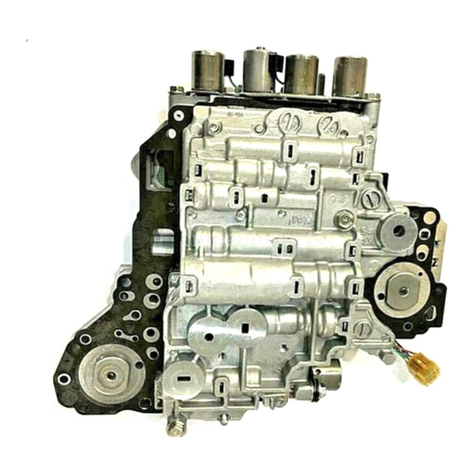
Jatco
Jatco RE4F04B manual
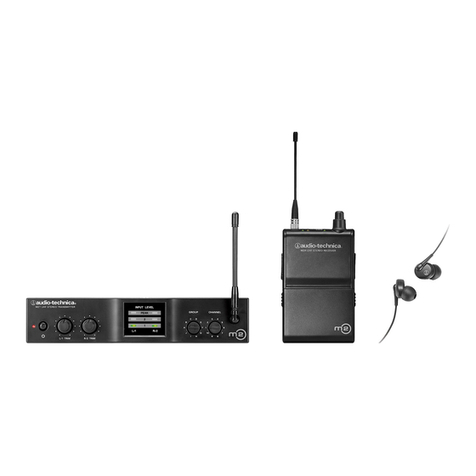
Audio Technica
Audio Technica M2 Setup and operation manual
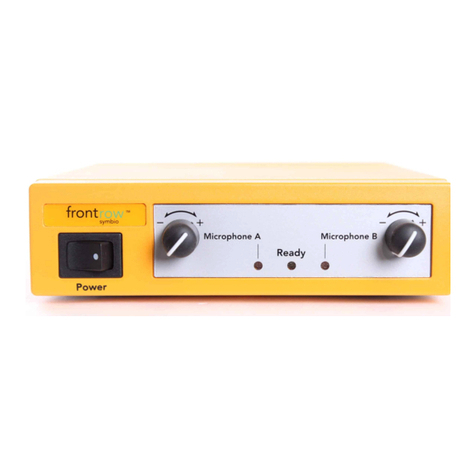
FrontRow
FrontRow symbio 5201R Installer's guide
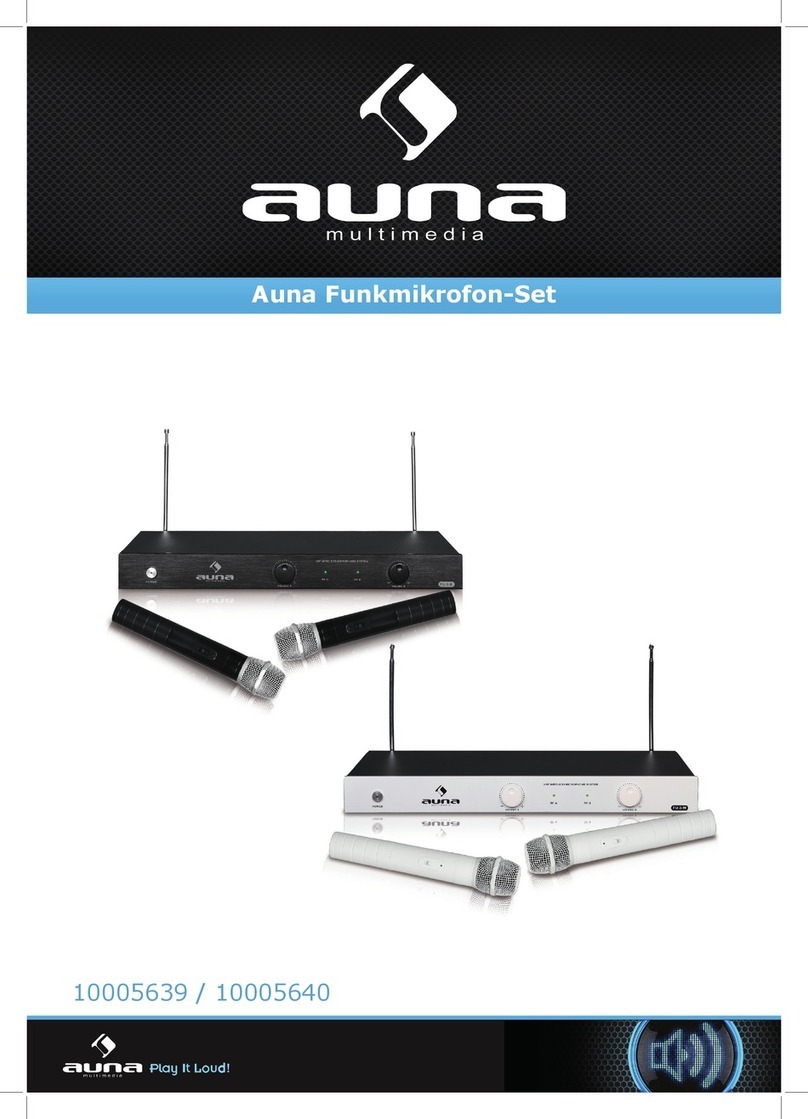
auna
auna 10005639 manual
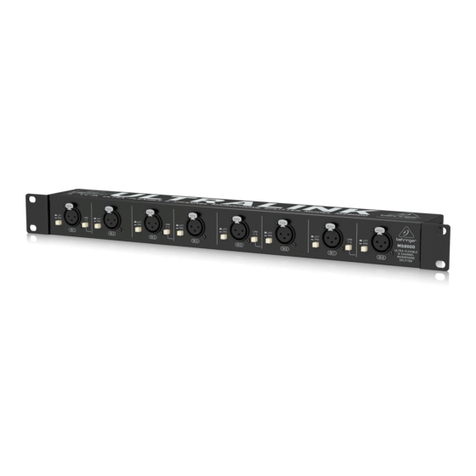
UltraLink Products
UltraLink Products Ultralink ms8000 quick start guide
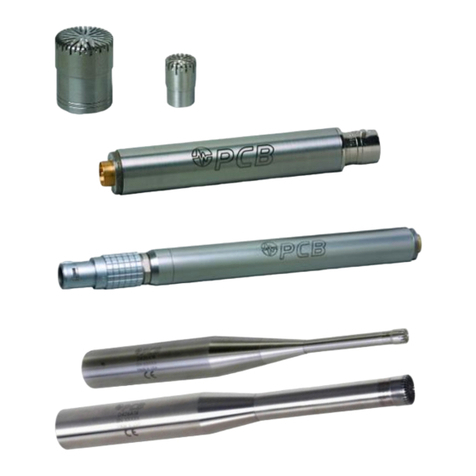
PCB Piezotronics
PCB Piezotronics 426 Series Installation and operating manual
